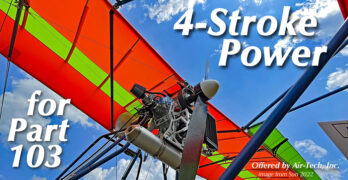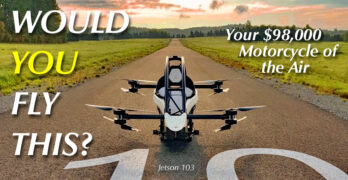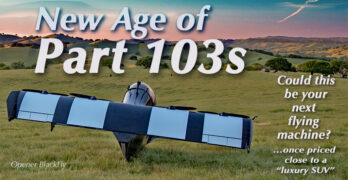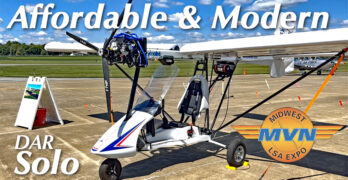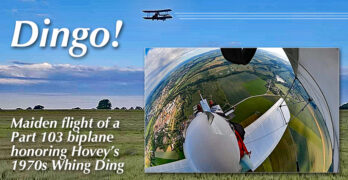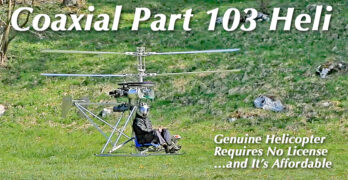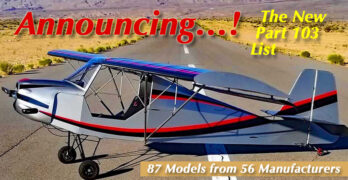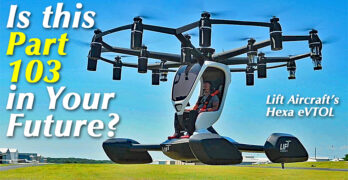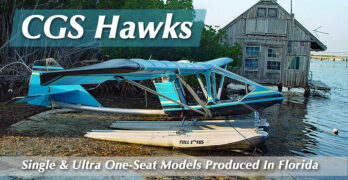If I hear one thing over and over it is this: “I want a four-stroke engine for my Part 103 ultralight. Are any available?”
For years the answer was, “Well, brand XYZ offered one but they disappeared from the market some years ago. One such winner I flew was the Bailey four-stroke out of England. However, a visit to their website recently was not very productive. Regretfully, other four-stroke powerplants are rare (although for slightly larger airplanes, Chip Erwin’s V-Twin will soon add to the choices).
Are you out of luck trying to obtain a Part 103 four-stroke? NOPE!
Aero 1000 Engine
Fine Swiss Engineeering
Air-Tech, Inc., is one of my favorite companies. While I love the people behind this Louisiana company, it isn’t their deep expertise, long experience, or even an endearing sense of humor that surrounds the Bornes — a father and son team to envy.
Search Results for : Part 103
Not finding exactly what you expected? Try our advanced search option.
Select a manufacturer to go straight to all our content about that manufacturer.
Select an aircraft model to go straight to all our content about that model.
George Jetson Flying Machine — Now a Reality and a Qualifying Part 103 Ultralight?
Air taxis — eVTOLs — UAVs — UASs — UAMs. I like “multicopters,” but the name game continues.
Maybe these new-fangled flying contraptions have numerous (indecipherable) names because they’re still deciding which way they’re headed?
I believe aircraft like these are nearly inevitable and I not only don’t resist, I’m rather enthusiastic about them. I’d love to get picked up from my driveway and whisked by air to an appointment across town in minutes, free of clogged roads. C’mon, UberAir!
However, that dream may be years in the future. Oh, the technology is nearly ready now. It hasn’t been proven to be in-the-field robust yet but engineers know today most of what they need to make air taxis viable. Their much bigger challenge? Gaining public acceptance and winning regulatory approval. That could take a long time. Meanwhile…
What’s Here TODAY?!
Air taxis may be fuzzy in the distance but another class of these machines is nearly ready for market.
Invasion of the Part 103 Multicopters — Surveying 5 Entries, All “No Pilot License Required”
These new-millennia flying machines have inspired multiple names. While an eventual winner is determined, a common handle seems to be the rather awkward “eVTOL” — for electric vertical takeoff and landing. A range of abbreviations are also used: UAV, UAM, UAS, autonomous aircraft, and several others. I like multicopter — because all of them involved multiple propellers doing the lifting.
Most commonly, you hear “drone.”
Yet “drone” is further confusing because we haven’t separated crewed aircraft from uncrewed aircraft and this is a major distinction. FAA has also made this separation, so for this article, I will only speak of crewed aircraft, that is, a flying machine with a pilot using controls to direct its flight. In addition, I will also stick solely to single place aircraft that can theoretically qualify as a legitimate Part 103 ultralight vehicle.
Let me first extend a quick thanks to IEEE’s Spectrum magazine for making me aware of entries I’d missed.
Midwest LSA Expo; Day 2 — DAR’s Solo Is An Affordable and Modern Part 103 Ultralight
Some kind of remarkable thing happened here in Mt. Vernon, Illinois where the Midwest LSA Expo is taking place. Out of the 30 or 40 airplanes on display, no less than three of them are what I’ll call “next generation” Part 103 ultralight entries.
It would be amazing to see three new ones of any sort, but all three of these are modern. They all use contemporary materials yet they have all been shown to qualify for FAA’s simplest regulation.
The three are Chip Erwin’s Merlin Lite, the AVI Swan I wrote about yesterday, and today’s subject: AeroplanesDAR’s Solo. All three are impressive and all three break away from the common Part 103 ultralight using “tube and gusset” construction
Two years ago I reported on the Merlin Lite and the pace of its innovative development has quickened. Chip’s popular entry will soon enter into a new production agreement so the airplanes will be assembled here in the USA by a longtime reliable expert.
Maiden Flight of Dingo — An Affordable Part 103 Biplane Honoring Hovey’s Whing Ding
When I look at Dingo from Future Vehicles, I see a fascinating blend of designs combining the looks of Aviad’s Zigolo Mg21 and Mike Loehle’s former Easy Riser. Yet Dingo isn’t some mashup of old designs. It’s been created by experienced engineers building with conventional construction but to Part 103 parameters.
Biplanes convey a vintage look but they also make for good hangar mates since their wingspan is usually shorter. Dingo is surprisingly compact with wings not even 22 feet wide.
Biplanes also fly slowly so complying with Part 103 speeds is not difficult.
Let’s learn more about this new entry from design engineer Marek Ivanov, a name alert readers may associate with a completely different design called Song (image below). Marek does engineering work for other aircraft producers as well. He leads “a team of experienced professionals with more than 20 years of experience in the aviation industry; they have participated in the development of more than 30 types of aircraft from ultralights to Part 23 (GA) aircraft.”
Maiden Flight of Dingo
On June 22nd 2022, Dingo took its maiden flight flown by test pilot Jan Jílek at the Jaroměř airport (LKJA).
Coaxial Helicopter that Meets Part 103… and You Can Afford It!
In a time of great spectator enthusiasm for STOL competitions, wouldn’t a VTOL be even better? If a super-short takeoff is cool, why not vertical takeoff?
Of course, most of the multicopter types — flying machines sometimes called eVTOLs — take off vertically but those are different, electric flying animals. Despite waves of breathless reporting by mainstream media types, eVTOLs are not yet ready for prime time. Even if you could buy one, you probably don’t want to pay for it. Most will be very expensive.
What if you could take off vertically this year and for a price you can actually afford?
Of course, rotary-wing enthusiasts can already choose a well-proven, made-in-the-USA helicopter that complies with Part 103 and is very affordable… for any aircraft type, but almost absurdly low-cost compared to conventional helicopters. I refer to the Mosquito XEL from Composite FX (see this video), which sells for $52,000 ready to fly or $42,000 in kit form.
Announcing: Launch of the Part 103 List, a One-of-a-Kind Resource in Affordable Aviation
To welcome a brand new year in affordable aviation, I am pleased to announce the launch of our Part 103 List. This new list presents 89 Part 103 entries for models built by 57 manufacturers.
[UPDATE 1/18/22 — We made the 103 List even better with the “Model column now leading to info right here on ByDanJohnson.com, when available. Other article changes are shown in red text. —DJ]
Too many people believe this is a minor sector with “no fixed wing aircraft that qualify.” They’re wrong; we have 38 fixed wing producers alone. Some others among the general aviation pilot population thought that Part 103 ultralights had disappeared completely. They could not be more wrong.
Not only are plenty of Part 103 ultralights being produced, they come in many diverse shapes and plenty of them are being sold.
Clearly, it’s about time a list like this one got published to put the record straight!
Part 103 Ultralight List
Welcome to our newest feature — Launched in January 2022 (Upgraded 1/18/22)
Part 103 Ultralight Vehicles are a special category within the FAA regulations. For one, they are not called “aircraft” as that helped detour around burdensome regulations for FAA approved aircraft. Instead, FAA called them “vehicles.”
The rule that brought 103 Ultralights into recognition was written in 1982 and has never been changed. It is the simplest, least intrusive FAA regulation available, so brief that it can be printed on the front and back of a single sheet of paper.
Why Is Part 103 So Great?
Part 103 Ultralight Vehicles are specially privileged. How are they special?
They do not need any FAA (N-number) registration.
They need no pilot certificate of any kind.
Therefore, no aviation medical is required to fly one.
The manufacturer can build a 103 ultralight ready-to-fly or in kit form so long as it meets the explanations offered in AC-103-7 — the official guidance for FAA field officers to use in evaluating if a flying machine qualifies as a 103 ultralight.
A Multicopter for the Rest of Us? Part 103 eVTOL Hexa Is Preparing for a U.S. Tour
You can hardly follow any media without finding some article about the latest whizzbang electric propulsion multicopter project that “will transform urban transportation!” Or so they breathlessly exclaim.
Fine. I look forward to going from a downtown hotel to the airport in minutes versus slogging through ground traffic for an hour. Will these arrive in some near future? Maybe. Even if they do arrive sooner than later, would a pilot feel entirely comfortable flying in an autonomous, computer-controlled aircraft? Only you can answer that question.
You might get a chance sooner than you think.
Whatever you think right now, would you change your mind if you got to fly one of these machines, safely, of course?
Since autonomous operation is part of the plan, a current-day Lift Aircraft Hexa could take over any time and land safely on its own. Heck, my ancient (3-year-old) DJI drone can do that, with zero input from me.
A Tale of Two Hawks; Proven & Affordable; One Makes Part 103
Since Chuck Slusarczyk’s first Hawk won Best New Design at Sun ‘n Fun in the spring of 1982 — the same year Part 103 was released — this affordable series of models has continued to increase its flock of smiling owners. Today around 2,500 Hawks of all varieties are flying. By my benchmark, that number separates lesser brands from those that achieve genuine market penetration.
Today the manufacturing of CGS’s Hawk line falls to two entities after the brand’s most recent rescuer, Terry Short, chose to focus on his own strengths. Terry had saved the design from its second owner after the original creator, Chuck, retired from the business. When Terry got busy building airplanes and supplying parts, he realized that it was a more diverse enterprise than originally anticipated. Therefore he was open when Bob Santom approached him.
In 2017, Bob Santom and his wife Marlene came to agreement and the Santom family took over rights and production of all CGS Hawk single-seat aircraft.
- « Previous Page
- 1
- 2
- 3
- 4
- …
- 53
- Next Page »


